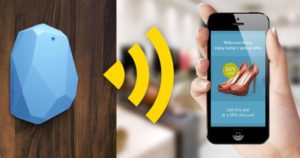What are Beacons?

Beacons use low-cost, low-power, micro-location-based technology to interact with electronical devices via Bluetooth Low Energy (BLE). Smart phones and other Bluetooth devices such as fitness trackers can be tracked by beacons using this technology. Beacons are primarily used for anonymous tracking of passers-by. More sophisticated beacons can be used for location-based mobile customer communication or even face
recognition.
The technology enables beacons to alert apps or websites (which the user has opted into) when someone approaches or leaves a location. This allows you to know who is approaching or visiting your store. Retail or other venues that have beacons in place can detect where a customer is (or rather when they are near the beacon). They can push timely messages to customers. Targeted marketing using geolocation isn’t brand new, but what makes beacon technology special is the ability to “wake up” an app a consumer has downloaded, but that isn’t open on the device. The technology is potentially transformational because of this ability, to wake up apps and re-engage consumers who may not remember to open up the app every time they come to the store.
The technology gained traction in 2013 when Apple introduced the iBeacon standard to the market. Google developed the Eddystone standard and rolled it out in July 2015. These are the two main protocols that the beacons use when engaging with nearby devices. Main difference between the two is that iBeacon requires an App to receive the transmission of the ID number from the beacon. The App can then trigger additional messages. The user must have Bluetooth on. The app should be set to receive pop-up notifications. Eddystone, in addition to the above, also allows URL links to be broadcasted. They come with support for sensor telemetry which makes them more powerful and enables beacon fleet management. However, for the URL links to work you need to have the Physical Web installed (native now on Chrome in Android). In addition Bluetooth and location
need to be turned on.
If your business already has an app in place and you want to have personalised engagement, then it’s easier to leverage iBeacon technology. It is easier to implement and gives you an ability to quickly get to market. If you don’t have an app in place, and you foresee to launch on a broad scale with an advanced beacon strategy you may want to explore Eddystone. This allows you to reach potential customers that have your app, but also other users without the need for a specific app. Be mindful though that if they don’t have a mobile app your interaction with the consumer is limited since you do not know who they are and can therefore not have the same tailored and personal content as a mobile app user.
There are a growing number of beacon brands around. They all have SDKs that allow solution providers to integrate the data streams they generate into their solutions. There are several companies in the beacon manufacturing space, such as Kontakt, Gelo, Estimote, Bleep and others. Apple does have one key feature that has interesting applications: an iPhone, iPad, or iPod can now become an iBeacon. It is noteworthy that the cheapest beacons are often battery powered, which require monitoring.
There are USB powered beacons with an adapter, in addition to having iPads to both act as a beacon and as an instore pad for your sales associates. More sophisticated beacons with Wifi support can also enable hotspot capabilities. This can enhance both the service side of the retail experience as well as the accuracy of the tracking